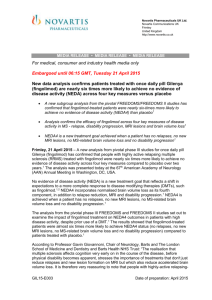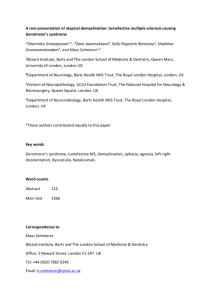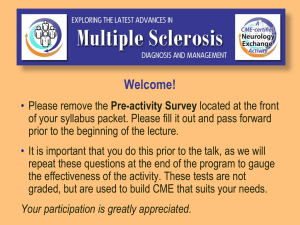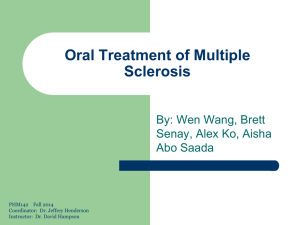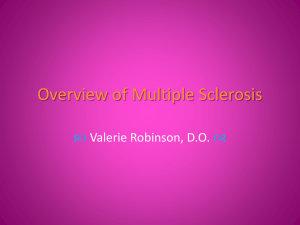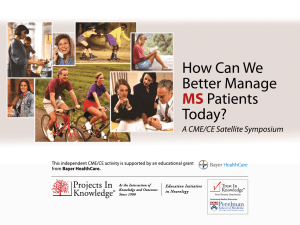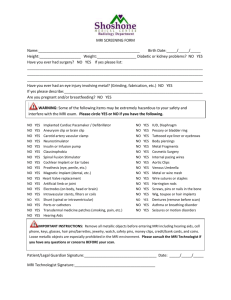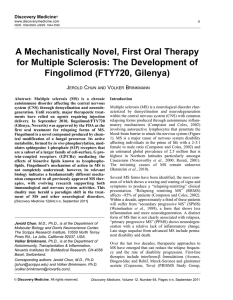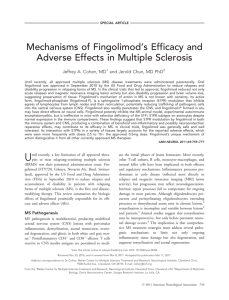Case report Fingolimod in active multiple sclerosis: an impressive
advertisement
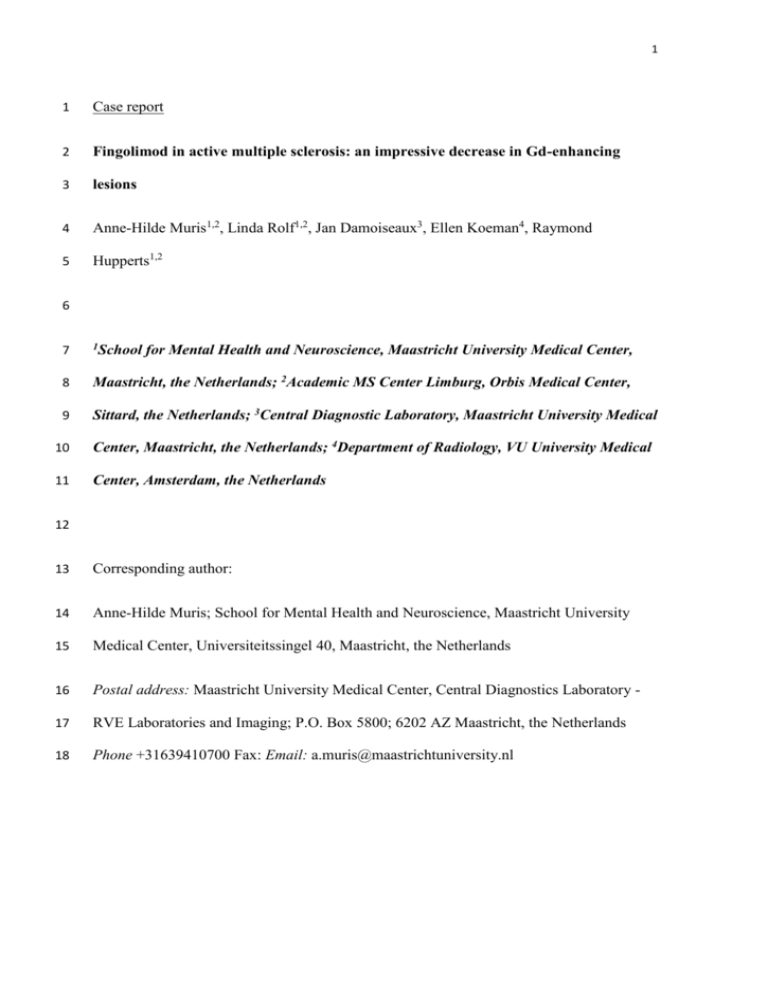
1 1 Case report 2 Fingolimod in active multiple sclerosis: an impressive decrease in Gd-enhancing 3 lesions 4 Anne-Hilde Muris1,2, Linda Rolf1,2, Jan Damoiseaux3, Ellen Koeman4, Raymond 5 Hupperts1,2 6 7 1School 8 Maastricht, the Netherlands; 2Academic MS Center Limburg, Orbis Medical Center, 9 Sittard, the Netherlands; 3Central Diagnostic Laboratory, Maastricht University Medical 10 Center, Maastricht, the Netherlands; 4Department of Radiology, VU University Medical 11 Center, Amsterdam, the Netherlands for Mental Health and Neuroscience, Maastricht University Medical Center, 12 13 Corresponding author: 14 Anne-Hilde Muris; School for Mental Health and Neuroscience, Maastricht University 15 Medical Center, Universiteitssingel 40, Maastricht, the Netherlands 16 Postal address: Maastricht University Medical Center, Central Diagnostics Laboratory - 17 RVE Laboratories and Imaging; P.O. Box 5800; 6202 AZ Maastricht, the Netherlands 18 Phone +31639410700 Fax: Email: a.muris@maastrichtuniversity.nl 2 19 Title: 77 characters 20 Wordcount summary: 162 words 21 Wordcount text: 1180 words 22 Figure: 1 23 Table: 0 24 References: 20 25 No supplementary data 3 26 Summary 27 Background 28 Fingolimod is a second line disease modifying therapy (DMT) in highly active relapsing 29 remitting multiple sclerosis (RRMS), as is natalizumab. Fingolimod decreases annual 30 relapse rates and gadolinium enhancing lesions on MRI as compared to either interferon 31 beta (IFNβ) or placebo. The effect of fingolimod on MRI outcomes compared to 32 natalizumab treatment has not been investigated in (head to head) clinical trials. Clinical 33 experience with natalizumab is much more extended and in general practice often 34 preferred. 35 Case presentation 36 This case describes a 31-year old woman with RRMS, who experienced severe side effects 37 on natalizumab. After a voluntary 4 months treatment free period, a severe relapse 38 appeared which was treated with prednisone and plasmapheresis; thereafter fingolimod 39 was initiated. In the following months MRI signs improved spectacularly. 40 Conclusion 41 This case suggests that fingolimod might be a good alternative for natalizumab, especially 42 for use in RRMS patients, with highly active, advanced disease, when natalizumab 43 treatment is stopped due to side effects or even after a severe relapse. 44 45 Keywords (alphabetical order): disease modifying therapies, fingolimod, multiple 46 sclerosis, MRI, relapsing remitting, T1gadolinium enhancing lesions, T2 lesions 4 47 Background 48 Fingolimod (FTY720, Gilenya®, Novartis Pharma AG, Basel, Switzerland) is like 49 natalizumab (Tysabri®, Biogen Idec Inc, Weston, MA, USA) a single disease 50 modifying therapy (DMT) in highly active relapsing remitting multiple sclerosis 51 (RRMS) patients. Fingolimod is registered in 80 countries across the world. In some 52 countries, like the USA, Switzerland, Australia and Russia, fingolimod is approved as 53 a first line treatment while in Europe and Canada fingolimod is a second line therapy 54 especially for those patients who are non-respondent to at least one other DMT like 55 interferon beta (IFNβ) or glatiramer acetate (GA) or who have rapidly evolving MS. 56 [1,2,3] 57 Fingolimod is an oral sphingosine 1-phosphate receptor modulator and acts as a 58 functional antagonist reducing the amount of circulating pathogenic lymphocytes by 59 inhibiting mainly naïve T cells and central memory T cells to egress from the lymph 60 nodes. It might also play a role in the neuroprotection of the central nervous system 61 (CNS). [4] Phase II and phase III studies with fingolimod have shown a decrease in 62 annual relapse rate, as well as a reasonable decline in gadolinium (Gd) enhancing 63 lesions on MRI, both in number and volume, after up to 36 months of fingolimod 64 treatment compared to either first line treatment with IFNβ or placebo. [5-7] 65 The effect of fingolimod compared to natalizumab treatment has never been 66 investigated in a head-to-head clinical trial. However, natalizumab was approved 67 approximately five years before fingolimod and therefore the clinical experience with 5 68 natalizumab is much more extended and in general practice often preferred. [1,2,8] 69 When natalizumab is discontinued, because of various reasons, a switch to fingolimod 70 is an obvious next step. However, reactivation of disease in patients switching from 71 natalizumab to fingolimod is reported in a considerable proportion of patients. [9-11] 72 Here we describe a case of a patient suffering from highly active RRMS treated with 73 fingolimod following a severe relapse after discontinuation of natalizumab and a 74 treatment free interval of four months, which we consider as a striking example of the 75 positive effect that fingolimod treatment may have especially on MRI outcome, even 76 after successful natalizumab treatment. 77 78 Case presentation 79 A 31-year old woman was diagnosed with RRMS at the age of 25. Three years before 80 diagnosis she presented with a first event of one-sided optic neuritis. She did not have 81 any further medical history. 82 Several first line treatments, i.e. GA and IFNβ-1b had insufficient effect: exacerbation 83 rate remained high and MR imaging showed a slight increase in lesion number (figure 84 1A). While second line therapy was not indicated because of patient’s desire to 85 become pregnant, treatment with intravenous immunoglobulins was initiated. 86 Immunoglobulins are not a registered therapy in MS, but can be used off-label if no 87 other options are available. [12] However, relapse rate remained high and one and a 6 88 half year after IFNβ-1b was stopped, she was still in a moderate clinical condition and 89 MRI showed multiple new Gd enhancing lesions. Therefore, after a third relapse 90 during immunoglobulin treatment, treatment with natalizumab was initiated. The one 91 relapse she experienced during the natalizumab treatment was in an early phase, and 92 therefore might have been still the result of the highly active MS before the effects of 93 natalizumab. MR imaging, 11 months after initiation of natalizumab, showed a slight 94 increase in white matter lesions without any Gd enhancing lesions (figure 1B). 95 However, at a later stage the patient was tested positive for anti-JC virus antibodies 96 and suffered from severe side effects, like frequent urinary tract infections and herpes 97 zoster infections. All together this made discontinuation of natalizumab after 20 98 months of treatment inevitable. After a voluntary treatment-free interval of four 99 months, she had a serious relapse with right sided hemiplegia, problems with 100 coordination, ataxia and dizziness, for which an acute admission into the hospital was 101 needed. Tests for JC-virus DNA in CSF were negative, excluding progressive 102 multifocal leucoencephalopathy (PML), but MRI of the brain showed an increased 103 number and volume of T2 lesions and Gd enhancing lesions throughout the white 104 matter (figure 1B). After plasmapheresis and methylprednisolone (MP) treatment, 105 control MRI showed only minor improvement. At that time fingolimod treatment was 106 started. From that moment on the patient’s condition gradually improved and she 107 remained relapse-free. Moreover, most recent MRI of the brain (8 months after the 108 initiation of fingolimod) showed a striking decrease in Gd enhancing white matter 109 lesions (figure 1A and 1B), without any new Gd enhancing lesions. 7 110 [FIGURE 1] 111 Natalizumab and fingolimod both are registered immunomodulatory therapies in 112 RRMS, currently known to have comparable effectiveness. Natalizumab, in general 113 practice frequently used, results in clinical and MRI stabilization, or even 114 improvement. [13] However, in the long term, natalizumab treatment has some 115 shortcomings. Side effects like frequent urinary tract infections or herpes infections 116 can occur. Also the increasing risk of getting PML in anti-JC virus antibody positive 117 patients can lead to discontinuation of treatment. Fingolimod, with a different 118 mechanism of action but shown to be also highly effective in reducing relapse rate in 119 RRMS, might therefore be a good alternative for natalizumab. [1,14] 120 A potential risk of natalizumab discontinuation is the risk of reactivation of disease, as 121 is also described in our case presentation. Radiological and clinical rebound, in which 122 disease activity of multiple sclerosis increases to levels even higher than baseline, has 123 been described between 1 and 6 months after discontinuation of natalizumab [15]. 124 However, in most cases disease activity returns to baseline with a peak in disease 125 activity 4 months after withdrawal [16]. Fingolimod has been described to potentially 126 mitigate the reactivation of disease after withdrawal of natalizumab. [17] However, 127 cases and studies have also been published reporting the occurrence of severe relapses 128 in the first months after switching from natalizumab to fingolimod have also been 129 reported [9-11]. These differences in outcome of fingolimod treatment used to 130 overcome disease reactivation might be due to differences in duration of the wash out 8 131 period of natalizumab. The wash out period between natalizumab and fingolimod is 132 considered not to exceed more than two or three months. [18,19] On the other hand, 133 recently an observational study showed that relapses after switching from natalizumab 134 to fingolimod occurred independently of the wash-out period. [20] 135 In this case presentation, fingolimod was not used to prevent a rebound effect or 136 reactivation of disease after discontinuation of natalizumab. Instead, after natalizumab 137 withdrawal initially the patient did not receive any immunomodulatory medication. 138 Only after the severe relapse, 4 months later, fingolimod was started. Afterwards, the 139 patient stabilized clinically and Gd enhancing lesions decreased spectacularly with 140 only one persistent Gd lesion and no new Gd enhancing lesions after 8 months (figure 141 1B). Although, Gd enhancing lesions may become inactive after 2-3 months, this 142 decrease from 54 T1 Gd enhancing lesions to only one persistent is conspicuous and a 143 treatment effect of fingolimod therefore almost undeniably. 144 145 Conclusions 146 This case shows and confirms that fingolimod might be radiologically and clinically 147 as effective as and a good alternative for natalizumab in highly active advanced 148 RRMS or possibly even in patients developing relapsing progressive MS, after 149 natalizumab cessation. Based on this case report one might speculate fingolimod to be 9 150 a good alternative for natalizumab in anti JC virus positive patients. Moreover, it 151 might even be useful in the treatment regime of a MS patient after a severe relapse. 152 Consent 153 Written informed consent was obtained from the patient for publication of this case 154 report and any accompanying images. A copy of the written consent is available for 155 review by the Editor of this journal. 156 Competing interests 157 AM, LR, JD, EK declare that there is no conflict of interest. RH received honoraria 158 for lectures and advisory boards and Research Grants from Merck, Biogen-Idec, 159 Sanofi-Genzyme, Novartis and TEVA. 160 Study funding 161 No financial support was received for this article. 162 Authors’ contributions: 163 Primary patient care and patient recruitment: RH 164 Manuscript drafting: AM and LR 165 Quantification of MRI data: EK 166 Critical revision of the manuscript: AM, LR, JD, EK and RH 10 167 References 168 1. European Medicines Agency; Gilenya summary of product characteristics. 169 2014. http://www.ema.europa.eu/docs/en_GB/document_library/EPAR_- 170 _Product_Information/human/002202/WC500104528.pdf (accessed July 171 2014) 172 2. U.S. Food and Drug Administration. Full Prescribing Information Fingolimod. 173 2014. 174 http://www.accessdata.fda.gov/drugsatfda_docs/label/2014/022527s009lbl.pdf 175 (accessed July 2014) 176 3. Novartis Media Releases, January 24, 2011. 177 http://www.novartis.com/newsroom/media-releases/en/2011/1481634.shtml 178 (accessed July 2014) 179 4. Mehling M, Johnson TA, Antel J, Kappos L, Bar-Or A: Clinical immunology 180 of the sphingosine 1-phosphate receptor modulator fingolimod (FTY720) in 181 multiple sclerosis. Neurology. 2011; 76: S20-27. 182 5. Comi G, O'Connor P, Montalban X, Antel J, Radue E-W, Karlsson G, 183 Pohlmann H, Aradhye S, Kappos L and FTY720D2201 Study Group: Phase II 184 study of oral fingolimod (FTY720) in multiple sclerosis: 3-year results. 185 Multiple sclerosis. 2010; 16: 197-207. 186 6. Khatri B, Barkhof F, Comi G, Hartung H-P, Kappos L, Montalban X, Pelletier 187 J, Stites T, Wu S, Holdbrook F, Zhang-Auberson L, Francis G, Cohen JA, on 188 behalf of the TRANSFORMS Study Group: Comparison of fingolimod with 11 189 interferon beta-1a in relapsing-remitting multiple sclerosis: a randomised 190 extension of the TRANSFORMS study. Lancet neurology. 2011; 10: 520-529. 191 7. Radue EW, O'Connor P, Polman CH, Hohlfeld R; Calabresi P, Selmaj K, 192 Mueller-Lenke N, Agoropoulou C, Holdbrook F, de Vera A, Zhang-Auberson 193 L, Francis G, Burtin P, Kappos L, for the FTY720 Research Evaluating 194 Effects of Daily Oral Therapy in Multiple Sclerosis (FREEDOMS) Study 195 Group: Impact of fingolimod therapy on magnetic resonance imaging 196 outcomes in patients with multiple sclerosis. Archives of neurology. 2012; 69: 197 1259-1269. 198 8. 199 200 Sorensen PS: New management algorithms in multiple sclerosis. Current opinion in neurology. 2014; 27(3): 246-259. 9. Rinaldi F, Seppi D, Calabrese M, Perini P and Gallo P: Switching therapy 201 from natalizumab to fingolimod in relapsing-remitting multiple sclerosis: 202 clinical and magnetic resonance imaging findings. Multiple sclerosis. 2012; 203 18: 1640-1643. 204 10. Daelman L, Maitrot A, Maarouf A, Chaunu MP, Papeix C, Tourbah A: Severe 205 multiple sclerosis reactivation under fingolimod 3 months after natalizumab 206 withdrawal. Multiple sclerosis. 2012; 18: 1647. 207 11. Centonze D, Rossi S, Rinaldi F, Gallo P: Severe relapses under fingolimod 208 treatment prescribed after natalizumab. Neurology. 2012; 6; 79(19): 2004- 209 2006. 12 210 12. 211 212 Houtchens MK, Kolb CM: Multiple sclerosis and pregnancy: therapeutic considerations. Journal of Neurology. 2013; 260: 1202–1214. 13. Filippini G, Del Giovane C, Vacchi L, D’Amico R, Di Pietrantonj C, Beecher 213 D, Salanti G: Immunomodulators and immunosuppressants for multiple 214 sclerosis: a network meta-analysis. The Cochrane database of systematic 215 reviews. 2013; 6: CD008933. 216 14. Braune S, Lang M and Bergmann A: Second line use of Fingolimod is as 217 effective as Natalizumab in a German out-patient RRMS-cohort. Journal of 218 neurology. 2013; 260(12): 2981-2985. 219 15. Vellinga MM, Castelijns JA, Barkhof F, Uitdehaag BM, Polman CH: 220 Postwithdrawal rebound increase in T2 lesional activity in natalizumab-treated 221 MS patients. Neurology. 2008; 25; 70(13Pt 2): 1150-1151. 222 16. O'Connor PW, Goodman A, Kappos L, Lublin FD, Miller DH, Polman C, 223 Rudick RA, Aschenbach W, Lucas N: Disease activity return during 224 natalizumab treatment interruption in patients with multiple sclerosis. 225 Neurology. 2011; 31; 76(22): 1858-1865. 226 17. Havla J, Tackenberg B, Hellwig K, Hellwig K, Meinl I, Krumbholz M, Seitz 227 F, Eienbröker C, Gold R, Hohlfeld R, Kleiter I, Kümpfel T: Fingolimod 228 reduces recurrence of disease activity after natalizumab withdrawal in multiple 229 sclerosis. Journal of Neurology. 2013; 260: 1382-1387. 13 230 18. Jokubaitis VG, Li V, Kalincik T, Izquierdo G, Hodgkinson S, Alroughani R, 231 Lechner-Scott J, Lugaresi A, Duquette P, Girard M, Barnett M, Grand'Maison 232 F, Trojano M, Slee M, Giuliani G, Shaw C, Boz C, Spitaleri DL, Verheul F, 233 Haartsen J, Liew D, Butzkueven H; MSBase Study Group: Fingolimod after 234 natalizumab and the risk of short-term relapse. Neurology. 2014; 8; 82(14): 235 1204-1211. 236 19. Cohen M, Maillart E, Tourbah A, De Sèze J, Vukusic S, Brassat D, Anne 237 OeWiertlewski S, Camu W, Courtois S, Ruet A, Debouverie M, Le Page E, 238 Casez O, Heinzlef OeStankoff B, Bourre B, Castelnovo G, Rico A, Berger E, 239 Camdessanche JP, Defer G, Clavelou P, Al Khedr A, Zephir H, Fromont 240 AePapeix C, Brochet B, Pelletier J, Lebrun C; Club Francophone de la 241 Sclérose en Plaques Investigators: Switching from natalizumab to fingolimod 242 in multiple sclerosis: a French prospective study. JAMA Neurology. 2014; 1; 243 71(4): 436-441. 244 20. Baldi E, Guareschi A, Vitetta F, Senesi C, Curti E, Montepietra S, Simone 245 AM, Immovilli P, Caniatti L, Tola MR, Pesci I, Montanari E, Sola P, Granella 246 F, Motti L, Ferraro D. Previous treatment influences fingolimod efficacy in 247 Relapsing-Remitting Multiple Sclerosis: results from an observational study. 248 Current Medical Research and Opinion. 2014; 15: 1-23 14 249 Figure 1. (A) Disease course from diagnosis, including (B) quantification of MRI 250 before and after start of fingolimod. Shown are patient’s treatment regime, relapses 251 (in closed dots when treated with methylprednisolone (MP), in open dots when 252 untreated), time points of all MR images and EDSS scores. The lower part of the 253 figure (figure 1B) shows the last five, most relevant, subsequent T2 FLAIR and T1 254 Gd MRI’s. T2 lesion count and lesion load and T1 Gd lesion counts are shown. T2 255 lesion count and lesion load were quantified by an expert reader in MIPAV (version 256 5.1.1, Center for Information Technology, Bethesda, Maryland). At follow up visits 257 subtracted images were used for MRI analyses. Total T2 lesion load at follow up was 258 calculated as the lesion load at baseline (MRI 1) plus negative and/or positive activity 259 change. 260 Time points of MRI in MS course: 261 MRI 1 – before start of natalizumab treatment (during exacerbation) 262 MRI 2 – just after restart natalizumab treatment (remission) 263 MRI 3 – during exacerbation 4 months after natalizumab discontinuation before 264 plasmapheresis 265 MRI 4 – during exacerbation 4 months after natalizumab discontinuation after 266 plasmapheresis 267 MRI 5 – 8 months after start of fingolimod (remission) 15 268 Abbreviations: DMT: disease modifying therapy; EDSS: Expanded Disability Status 269 Scale
